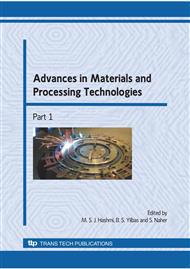p.810
p.818
p.826
p.834
p.842
p.850
p.858
p.866
p.874
Characterization of Colmonoy 227-F Samples Obtained by Direct Laser Metal Deposition
Abstract:
Direct Laser Metal Deposition (DLMD) is an emerging technique in the group of Material Accretion Manufacturing (MAM) processes because of the possibility to fabricate and to repair a wide range of metal components with a complex geometry, starting from metal powders. DLMD is a technology which combines computer aided design, laser cladding and rapid prototyping. Fully dense metallic parts can be directly obtained through melting coaxially fed powders with a laser. The success of this technology in the die and tool industry depends on the parts quality to be achieved. An accurate control of the parameters such as laser power, spot diameter, scanning speed and powder mass flow rate is fundamental to obtain the required geometric dimensions and material properties. In this work, the performance of the DLMD process was examined in terms of hardness, porosity, microstructure, and composition. A fitting equipment was built and used for the experiments together with a CO2 laser machine with a maximum power of 3 kW. The material used for experimental tests was Colmonoy 227-F, a Nickel alloy specially designed for glass container mould protection and restoration.
Info:
Periodical:
Pages:
842-849
Citation:
Online since:
December 2009
Price:
Сopyright:
© 2010 Trans Tech Publications Ltd. All Rights Reserved
Share:
Citation:


